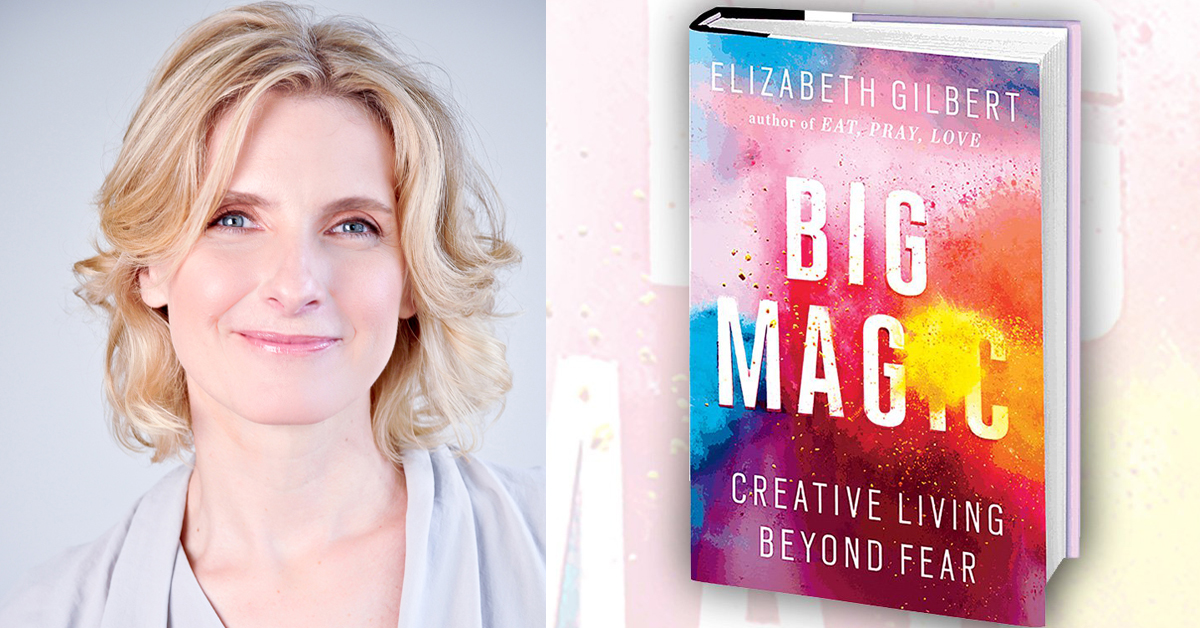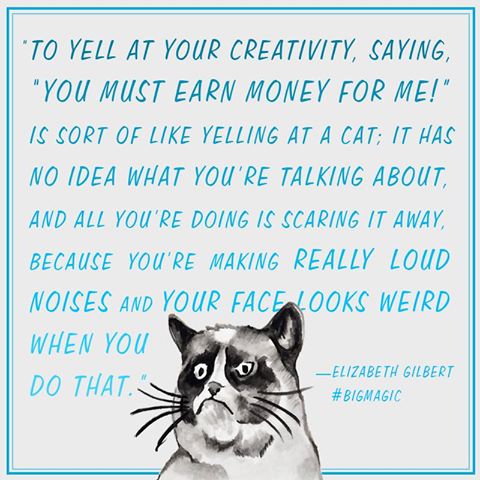Image from Charm Magazine
When was the last time you did something truly creative? How did it feel?
Whichever profession you are in, you will experience days of creative famine. These are the horrifying days when you feel stuck in a rut, unable to cough out anything faintly imaginative or intriguing.
What should you do when you hit a creative wall?
Enter Big Magic by bestselling author of Eat Pray Love, Elizabeth Gilbert.
Written with huge splashes of empathy, generosity and easy radiance, Big Magic shines like a beacon in a sea of creative darkness.
Eschewing common beliefs that creativity can only spew forth from tormented souls, Gilbert proposes instead that we should treat creativity like a delightful treasure hunt. One where we seek to uncover the “strange jewels” that are buried deep within us in order to live a more enchanted life.
Gilbert believes that creative living helps you achieve a state of transcendence. Quoting from the book:
“A creative life is an amplified life. It’s a bigger life, a happier life, an expanded life, and a hell of a lot more interesting life. Living in this manner – continually and stubbornly bringing forth the jewels that are hidden within you – is a fine art, in and of itself.”
So how can you do so?
Put Your Fear in the Backseat
Creative living begins with courage. It is a path for the brave. A journey where we battle insecurities and phobias that are bound to come our way.
While the right fear can keep us alive, the wrong kinds of fear disables our creativity.
I love Gilbert’s prescription for fear. It comes in the form of a welcome speech (extracted below):
“Dearest Fear: Creativity and I are about to go on a road trip together. I understand you’ll be joining us, because you always do. I acknowledge that you believe you have an important job to do in my life, and that you take your job seriously.
Apparently, your job is to induce complete panic whenever I’m about to do anything interesting – and may I say, you are superb at your job. So by all means, keep doing your job, if you feel you must.
But I will also be doing my job on this road trip, which is to work hard and stay focused. And Creativity will be doing its job, which is to remain stimulating and inspiring. There’s plenty of room in this vehicle for all of us, so make yourself at home, but understand this:
Creativity and I are the only ones who will be making any decisions along the way.
…You’re allowed to have a seat, and you’re allowed to have a voice, but you are not allowed to have a vote. You’re not allowed to touch the road maps; you’re not allowed to suggest detours; you’re not allowed to fiddle with the temperature. Dude, you’re not every allowed to touch the radio.
But above all else, my dear old familiar friend, you are absolutely forbidden to drive.”
Catch Genius When It Comes (But Don’t Wait for It)
We all know that inspiration is fleeting. However, do you know that it can move from person to person, searching for the right host to “infect”?
Relating how an idea for a book on the Amazon jungle eerily migrated to fellow author Ann Patchett, Gilbert suggested that genius is “caught and not taught”.
This concept of multiple discoveries is elegantly related by American poet Ruth Stone.
As a child growing up on a farm in rural Virginia, Ruth could sometimes hear a poem coming towards her like a galloping horse rushing across the land. She would then “run like hell” towards the house so that she can stay ahead of the poem, and catch it with a pencil and paper.
Though the euphoric feeling when inspiration strikes is amazing, we are advised to “let it come and let it go”. In other words, we should continue creating our art, and put it out there for the world (or ourselves) to savour.
Be Light and Unburdened (Like Tom Waits)
“I realised that, as a songwriter, the only thing I really do is make jewelry for the inside of other people’s minds.” – Tom Waits
I am a huge fan of singer and songwriter Tom Waits, especially his iconic love song “Missing You” (hear it below). So it was a treat to learn from his life experience.
https://www.youtube.com/watch?v=K5J1mn_u0rM
In the section on “Permission”, Tom Waits shared how his children motivated him to deal with his creativity more lightly – without drama or fear.
Totally liberated in expressing themselves creatively, his kids made up songs on the fly and toss them out “like little origami things, or paper airplanes.” They would then sing the next song and the next, without ever worrying that the flow of ideas would dry up.
Likewise, you should treat creativity like “jewelry” for the inside of other people’s minds (or your own). Our creative efforts are just decoration, not something that is life and death. So don’t get your undies in a knot and learn to relax and chill.
What’s Your Favourite Flavour of Sh*t Sandwich?
Which brings us to the next point about creativity: Eating your own sh*t sandwich.
First coined by Mark Manson, the idea here is that “every single pursuit – no matter how wonderful and exciting and glamorous it may initially seem – comes with its own brand of sh*t sandwich.”
In other words:
“Everything sucks, some of the time.” – Mark Manson
If you truly love something and wait it bag enough, you wouldn’t mind the “side effects” which came with it.
Treat Creativity as a Vocation – Not a Career
Courtesy of Elizabeth Gilbert
The irony about succeeding in any creative pursuit is to give it levity and space. In other words, you should not burden your creativity with the need to generate an income. (Hmm…)
Citing that “creative fields make for crap careers”, Gilbert suggests that you should take up a day job to pay the bills and fund your creativity. Here’s what she did (from her Facebook post):
“I wrote my first book while I was a diner waitress. I wrote my second book while I was a diner waitress and a bartender. I wrote my third book while I was a bartender who also worked in a bookstore and who also worked as a journalist. When EAT PRAY LOVE (my fourth book) came out, I was still working at a flea market on weekends. If it wasn’t for the bananas success of EAT PRAY LOVE, I would still be doing other jobs.”
By doing so, you will worry less about what other people think, and more with what you enjoy doing for its own sake.
Hopefully, like a “beautiful beast that comes rushing into the glade”, success may find you.
Think Like a Trickster (not Martyr)
Imploring us to release the idea of “suffering for our creativity”, Gilbert suggests that we should reject the way of the martyr and embrace the way of the trickster.
A martyr’s energy is dark, solemn, macho, hierarchical, fundamentalist, austere, unforgiving, and profoundly rigid.
On the other hand, a trickster’s energy is light, sly, transgender, transgressive, animist, seditious, primal, and endlessly shape-shifting.
A martyr would say: “Life is pain.”
While a trickster would say: “Life is interesting.”
The big message here is this:
Creativity Thrives Under Curiosity – Not Passion
Accessible to everyone, curiosity is milder, quieter, more welcoming and more democratic than passion. It doesn’t compel you to “get divorced and sell all your possessions and shave your head and move to Nepal” but only asks the simple question: “Is there anything you’re interested in?”
Embrace the Paradox of Creative Living
Towards the end of the book, Gilbert related a charming tale from her Eat Pray Love sojourn in Bali.
Shared by her spiritual teacher Ketut Liyer, it narrated how the “exquisite, intricate, and ancient” Balinese dances which were ritually performed in temples became a tourist attraction over the years. To appease high-minded Westerners who found it sacrilegious – such dances were performed at tourist resorts – a separate “fake” form of the dance was specially developed for tourists.
Interestingly, the new fake dances became even better and more transcendent than the original “sacred” versions. The Balinese priests then decided to borrow the new fake dances, incorporate them into the ancient religious ceremonies, and use them as a form of prayer.
This blurring of the lines between the authentic and the fake encapsulated the paradox of creativity”
“Only when we are at our most playful can divinity finally get serious with us.”
The Quintessence of Inspiration
Quirky and witty while effusing much warmth and sincerity, Big Magic is a phenomenally good read.
While I may not subscribe to all of its notions, I found much encouragement from Elizabeth Gilbert’s beautifully written prose. What struck me especially hard was the idea that creativity begins from a place of serendipitous delight – not suffering and sacrifice.
To learn more about the book – and Elizabeth Gilbert’s ideas on creativity – do watch Marie Forleo’s wonderful interview below:


